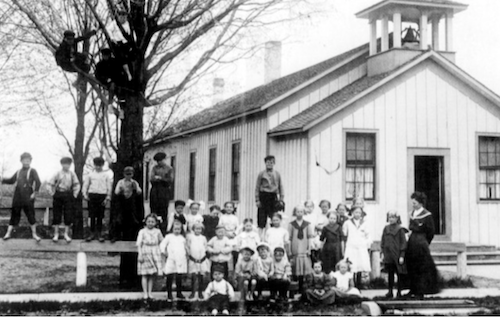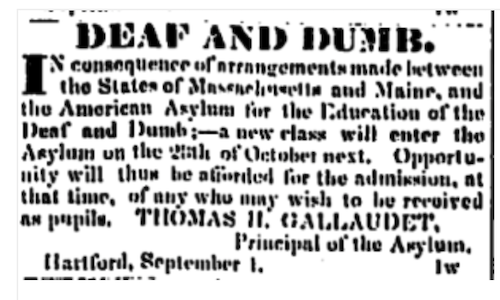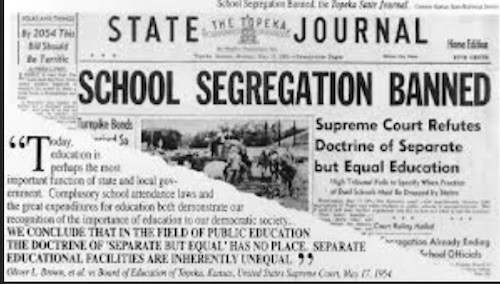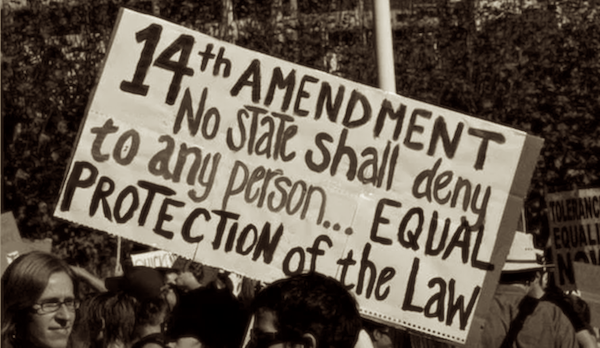Disabled Child Discriminated Agains Tin Us School
In these days, it is doubtful that any child may reasonably be expected to succeed in life if he is denied the opportunity of an teaching. - Dark-brown five. Board of Education, 347 U.Due south. 483 (1954)
To sympathize the battles being fought today for children with disabilities, information technology is important to understand the history and traditions associated with public schools and special education. In this chapter, you will learn about the evolution of public education and special pedagogy, the impact of several landmark bigotry cases, and the circumstances that led Congress to enact Public Law 94-142 in 1975.
Common Schools Teach Common Values
Waves of poor, non-English speaking, Cosmic and Jewish immigrants poured into the U.s.a. during the 19th and early 20th centuries. Citizens were afraid that these new immigrants would bring class hatreds, religious intolerance, criminal offence, and violence to America. Social and political leaders searched for means to "accomplish down into the lower portions of the population and teach children to share the values, ethics and controls held by the rest of society."

An educational reformer named Horace Mann proposed a solution to these social problems. He recommended that communities establish common schools funded past tax dollars. He believed that when children from different social, religious and economic backgrounds were educated together, they would learn to accept and respect each other. Common schools taught mutual values that included self-discipline and tolerance for others. These mutual schools would socialize children, improve interpersonal relationships, and better social weather condition.
For public schools to succeed in the mission of socializing children, all children had to attend school. Poor children attended school sporadically, quit early, or didn't enter school at all. Public school authorities lobbied their legislatures for compulsory school attendance laws. Compulsory attendance laws gave school officials the power to prosecute parents legally if they failed to send their children to school.
Early Special Teaching Programs
The outset special teaching programs were delinquency prevention programs for "at risk" children who lived in urban slums. Urban school districts designed manual training classes equally a supplement to their general pedagogy programs. Past 1890, hundreds of thousands of children were learning carpentry, metal work, sewing, cooking and drawing in manual classes. Children were also taught social values in these classes. Early special instruction programs likewise focused on the "moral preparation" of African-American children.
Special schools and special classes for children with disabilities, especially deafness, incomprehension, and mental retardation did exist in 19th century America and gradually increased during the 20th century.

Advertising for the Asylum for the Educational activity of the Deaf and Dumb,
The Connecticut Courant, September 8, 1829
Programs for children with specific learning disabilities (chosen "brain injury," "minimal brain dysfunction," and otherterms) became more common in the 1940's.
However, near early special education programs were private and/or residential. The quality and availability of programs varied between and within states. Proficient special education programs were rare and difficult to admission. For most children with disabilities, special education programs were simply not available. Brown v. Board of Education (1954) In 1954, the U. S. Supreme Courtroom issued a landmark civil rights decision in Chocolate-brown v. Lath of Educational activity. In Brown, school children from four states argued that segregated public schools were inherently unequal and deprived them of equal protection of the laws. The Supreme Court establish that African-American children had the correct to equal educational opportunities and that segregated schools "take no place in the field of public education." The Court wrote: Today, educational activity is perhaps the virtually important function of land and local governments. Compulsory school attendance laws and the great expenditures for education both demonstrate our recognition of the importance of pedagogy to our autonomous order. It is required in the operation of our most bones public responsibilities, even service in the armed services. It is the very foundation of proficient citizenship. Today, it is a principal instrument in enkindling the child to cultural values, in preparing him for later professional training, and in helping him to conform usually to his environment. In these days, information technology is doubtful that whatsoever child may reasonably be expected to succeed in life if he is denied the opportunity of an pedagogy. Such an opportunity, where the land has undertaken to provide it, is a right that must be fabricated available to all on equal terms. Nosotros come up and then to the question presented: Does segregation of children in public schools solely on the ground of race, even though the physical facilities and other "tangible" factors may be equal, deprive the children of the minority group of equal educational opportunities? We believe that it does. In Brown, the Supreme Court described the emotional bear upon that segregation has on children, especially when segregation "has the sanction of the law:" To split up them from others of similar age and qualifications solely because of their race generates a feeling of inferiority every bit to their status in the community that may affect their hearts and minds in a way unlikely ever to be undone. The effect of this separation on their educational opportunities was well stated past a finding in the Kansas instance by a courtroom that nonetheless felt compelled to rule against the Negro plaintiffs: Segregation of white and colored children in public schools has a detrimental upshot upon the colored children. The impact is greater when it has the sanction of the police force; for the policy of separating the races is commonly interpreted as denoting the inferiority of the Negro group. A sense of inferiority affects the motivation of a kid to larn. Segregation with the sanction of law, therefore, has a tendency to [retard] the educational and mental development of Negro children and to deprive them of some of the benefits they would receive in a racially integrated school organization. After the determination in Dark-brown, parents of children with disabilities began to bring lawsuits confronting their schoolhouse districts for excluding and segregating children with disabilities. The parents argued that, past excluding these children, schools were discriminating against the children because of their disabilities. Elementary and Secondary Education Act of 1965 (ESEA) Congress enacted the Elementary and Secondary Education Act (ESEA) in 1965 to accost the inequality of educational opportunity for underprivileged children. This landmark legislation provided resources to help ensure that disadvantaged students had access to quality pedagogy. In 1966, Congress amended the ESEA to establish a grant programme to help states in the "initiation, expansion, and comeback of programs and projects . . . for the teaching of handicapped children." In 1970, Congress enacted the Education of the Handicapped Act (P.Fifty. 91-230) in an effort to encourage states to develop educational programs for individuals with disabilities. According to the National Council on Disability: Congress first addressed the education of students with disabilities in 1966 when information technology amended the Uncomplicated and Secondary Educational activity Act of 1965 to establish a grant program to assist states in the "initiation, expansion, and comeback of programs and projects . . . for the educational activity of handicapped children." In 1970, that program was replaced by the Education of the Handicapped Act (P.L. 91-230) that, like its predecessor, established a grant programme aimed at stimulating the States to develop educational programs and resources for individuals with disabilities. Neither plan included any specific mandates on the use of the funds provided past the grants; nor could either program be shown to have significantly improved the pedagogy of children with disabilities. PARC and Mills During the early 1970s, two cases were catalysts for change: Pennsylvania Assn. for Retarded Children five. Commonwealth of Pennsylvania (PARC) and Mills v. Board of Education of District of Columbia. PARC dealt with the exclusion of children with mental retardation from public schools. In the subsequent settlement, it was agreed that educational placement decisions must include a process of parental participation and a means to resolve disputes. Mills involved the practice of suspending, expelling and excluding children with disabilities from the District of Columbia public schools. The school district's primary defense in Mills was the loftier cost of educating children with disabilities. Judge Waddy wrote: The genesis of this case is institute (i) in the failure of the District of Columbia to provide publicly supported educational activity and grooming to plaintiffs and other "infrequent" children, members of their class, and (two) the excluding, suspending, expelling, reassigning and transferring of "exceptional" children from regular public schoolhouse classes without affording them due procedure of police. The inadequacies of the District of Columbia Public School System whether occasioned by insufficient funding or administrative inefficiency, certainly cannot be permitted to deport more heavily on the "exceptional" or handicapped child than on the normal child. Congressional Investigation (1972) Later on PARC and Mills, Congress launched an investigation into the status of children with disabilities and institute that millions of children were non receiving an appropriate educational activity: Yet, the well-nigh recent statistics provided by the Agency of Education for the Handicapped estimated that of the more eight meg children . . . with handicapping conditions requiring special teaching and related services, only 3.ix million such children are receiving an appropriate didactics. one.75 million handicapped children are receiving no educational services at all, and 2.v million handicapped children are receiving an inappropriate education. The investigation so moved members of Congress that they wrote: The long-range implications of these statistics are that public agencies and taxpayers volition spend billions of dollars over the lifetimes of these individuals to maintain such persons as dependents and in a minimally acceptable lifestyle. With proper education services, many would be able to become productive citizens, contributing to society instead of existence forced to remain burdens. Others, through such services, would increase their independence, thus reducing their dependence on social club. There is no pride in being forced to receive economic assistance. Not only does this take negative effects upon the handicapped person, but it has far-reaching furnishings for such person'south family. Providing educational services will ensure against persons needlessly being forced into institutional settings. One need only look at public residential institutions to find thousands of persons whose families are no longer able to treat them and who themselves take received no educational services. Billions of dollars are expended each year to maintain persons in these subhuman conditions . . . Parents of handicapped children all as well frequently are not able to advocate the rights of their children because they accept been erroneously led to believe that their children will not exist able to atomic number 82 meaningful lives . . . . It should non . . . exist necessary for parents throughout the land to go on utilizing the courts to assure themselves a remedy . . . . In 1972, legislation was introduced in Congress later several "landmark court cases establishing in law the right to educational activity for all handicapped children." Public Police force 94-142: The Pedagogy for All Handicapped Children Act of 1975 On Nov 19, 1975, Congress enacted Public Law 94-142 in 1975, likewise known equally The Education for All Handicapped Children Act of 1975. Congress intended that all children with disabilities would "have a right to education, and to establish a process by which State and local educational agencies may exist held accountable for providing educational services for all handicapped children." Initially, the law focused on ensuring that children with disabilities had access to an education and due process of law. Congress included an elaborate system of legal checks and balances called "procedural safeguards" that are designed to protect the rights of children and their parents. The law has been reauthorized several times, most recently in 2004. Did Your State Pass the Thought Compliance Test? (The Special Ed Abet, October 11, 1999) On Oct eleven, 1999, we published an issue of The Special Ed Advocate that included several articles, including #3: "Did Your State Pass the Idea Compliance Test?" We explained that your state Department of Instruction has many responsibilities under IDEA. "Your state education department should accept a comprehensive system of personnel development that is designed to ensure that there is an adequate supply of properly trained teachers. "Your state should have policies and procedures that ensure that all children with disabilities receive a free appropriate instruction. "Your land is responsible for implementing a comprehensive Child Notice Program where all children with disabilities (including children who attend individual schools) are identified, located and evaluated." Nosotros asked, "Did your state pass the IDEA Compliance Test?" Co-ordinate to information previously released by the National Council on Inability, "Most states failed." "Based on the U.Due south. Department of Teaching's monitoring of state compliance with IDEA from 1994 to 1998, 90 pct of states and territories neglect to adequately supervise local education agencies {school district's] educational activity of students with disabilities." "Fourscore-8 percent do non comply with requirements to provide services to assist a student's transition from school to mail-didactics activities." On November 23, 1999, we reported that the Thought Compliance Report Was Delayed IDEA Compliance Report: Back to School on Ceremonious Rights - "States Ignore Special Ed Law" On January 25, 2000, the National Council on Disability (NCD) released the long awaited report of the federal data: enforcement and compliance with the Individuals With Disabilities Education Act, Part B (IDEA), concluding that "Federal efforts to enforce the police force over several administrations take been inconsistent, ineffective and defective any real teeth . . ." "Many children with disabilities are getting substandard schooling considering states are non complying with federal rules on special teaching . . ." "In too many cases, children with disabilities are taught in split classrooms and schools are not post-obit other regulations meant to protect these students from bigotry." "Considering the U. South. Section of Pedagogy doesn't require states to comply with the police force, 'parents frequently must sue to enforce the law . . .'" "About half-dozen 1000000 American children receive special education instruction and services at a cost of almost $40 billion, about $5.7 billion of which is federal money." After examining compliance reports from 1994 to 1998, the National Council on Disability concluded that: The Quango on Disability concluded that special educational activity would not fulfill its mission until states are required to comply with the constabulary. The Associated Press reported that, "The Council fabricated dozens of recommendations to strengthen federal enforcement. They include giving the Justice Department independent authority to investigate cases and take states to court; providing more money for enforcement and handling of complaints; and creating a process for handling complaints at the federal level." We spent days formatting the Thought Compliance Report into html, creating hundreds of internal links, and uploading the unabridged Report onto Wrightslaw.com. Individuals with Disabilities Education Improvement Deed of 2004 Congress has amended and renamed the special education law several times since 1975. On December iii, 2004, the Individuals with Disabilities Education Act was amended over again. The reauthorized statute is the Individuals with Disabilities Educational activity Comeback Act of 2004 and is known as Idea 2004. The statute is in Volume 20 of the United States Lawmaking (U. South. C.), commencement at Section 1400. The special education regulations are published in Volume 34 of the Code of Federal Regulations (CFR) beginning at Department 300. In reauthorizing the Thought, Congress increased the focus on accountability and improved outcomes by emphasizing reading, early on intervention, and research-based instruction by requiring that special education teachers be highly qualified. Purposes The Individuals with Disabilities Didactics Act of 2004 has two primary purposes. The first purpose is to provide an didactics that meets a child's unique needs and prepares the child for further education, employment, and contained living. The 2d purpose is to protect the rights of both children with disabilities and their parents. Finding: Overrepresentation of Minority Children In 1975, Congress plant that poor African-American children were over-represented in special education. These problems accept persisted. In the Findings of Idea 2004, Congress described ongoing problems with the over-identification of minority children, including mislabeling and high dropout rates: (A) Greater efforts are needed to prevent the intensification of problems continued with mislabeling and high dropout rates among minority children with disabilities. (B) More minority children go on to be served in special education than would be expected from the pct of minority students in the general school population. (C) African-American children are identified every bit having mental retardation and emotional disturbance at rates greater than their White counterparts. (D) In the 1998-1999 school yr, African-American children represented just fourteen.viii percent of the population anile 6 through 21, merely comprised 20.two percent of all children with disabilities. (E) Studies take plant that schools with predominately White students and teachers have placed disproportionately loftier numbers of their minority students into special education. Aligning Idea and NCLB When Congress reauthorized the Thought in 2004, they emphasized the demand to align the Thought with other school improvement efforts, specifically "comeback efforts under the Simple and Secondary Education Act of 1965." Congress found that: . . . the educational activity of children with disabilities can exist fabricated more effective by . . . having high expectations for such children and ensuring their access to the general teaching curriculum in the regular classroom . . . to meet developmental goals and . . . the challenging expectations that accept been established for all children . . . . The purpose of the No Kid Left Behind Act of 2001 was "to ensure that all children take a fair, equal, and significant opportunity to obtain a high-quality education and reach, at a minimum, proficiency on challenging State bookish achievement standards and state academic assessments." IDEA required states to found goals for the performance of children with disabilities that are consequent with the goals and standards for nondisabled children. States were also required to improve graduation rates and dropout rates and to report the progress of children with disabilities on land and district assessments. In Findings of Thought 2004, Congress described a disquisitional demand for adequately trained personnel and that "high quality, comprehensive professional evolution programs were essential to ensure that the persons responsible for the education or transition of children with disabilities possess the knowledge and skills necessary to address the educational and related needs of those children." No Child Left Behind Out, Every Student Succeeds Act In In 2015, Congress reauthorized the Uncomplicated and Secondary Education Act (ESEA), the statute formerly known as the No Kid Left Backside Human action. In response to complaints from states and school districts, Congress removed many portions of the law about accountability -- including requirements for highly qualified teachers. The new educational activity statute, Every Pupil Succeeds Act, was signed into law by President Obama on December ten, 2015. Report on State Implementation of IDEA (Nov 25, 2020). https://www2.ed.gov/fund/data/study/idea/ideafactsheet-determinations-2020.pdf ********** Legal references and citations for this article tin can be found in Wrightslaw: Special Education Law, 2d Edition, Affiliate 3.





Most states neglect education obligations to special needs students:
So, what else is new? USA Today (August eight, 2020)
To top
Last revised: x/18/21
millenderdisid1937.blogspot.com
Source: https://www.wrightslaw.com/law/art/history.spec.ed.law.htm
0 Response to "Disabled Child Discriminated Agains Tin Us School"
Post a Comment